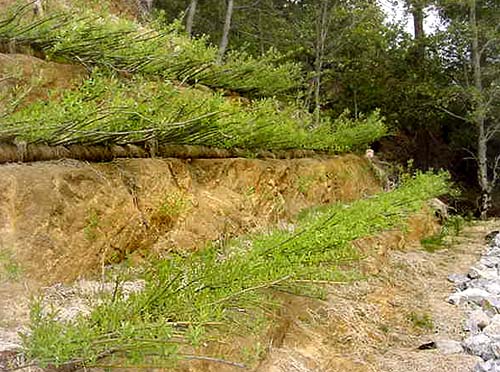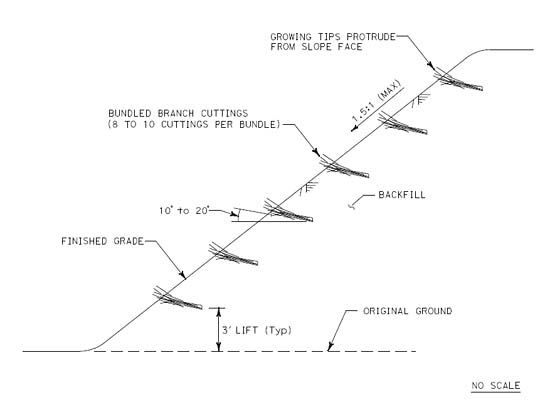Erosion Control Toolbox: Brush Layering
Introduction

Brush layering work includes harvesting green cuttings from existing cottonwood or willow stands and embedding these cuttings in horizontal layers perpendicular to the slope face.
Click here to watch a short video about Brush Layering.
When to Use This Treatment
- Most commonly used to construct 2:1 (H:V) embankment (fill) slopes.Can be used with excavation (cut) slopes if combined with stepped slope techniques.
- Coordinate the use of this technique with Caltrans Division of Engineering Services (DES) Office of Geotechnical Services, which may prepare a Geotechnical Design Report for slopes greater than 2:1 (H:V).
- This treatment is used to provide erosion protection, increase vegetative cover, and enhance habitat.

Note: This typical section is schematic only and is not to be used in a contract document. The scale, key dimensions, and critical details have been intentionally omitted.
Consider Using With
Benefits
- Provides immediate surface slope reinforcement with unrooted brush cuttings
- Slope stability and shear resistance increase as root development occurs
- Creates slope breaks that shorten slope length and reduce stormwater runoff velocities
- Creates vegetative filters that trap sediment
- Promotes vegetation establishment, cover, and natural recruitment
Limitations
- Requires accessible, local stand of cottonwoods or willows from which to harvest cuttings
- Harvesting of cuttings may require a permit and a project construction window
- Not recommended for rocky slopes, slopes with extremely low soil moisture through the dry season, or slopes with limited equipment access
- May require supplemental irrigation during establishment period, particularly during the first dry season and on south-facing slopes
Details
- Brush Layer With Soil Wrap Detail (Microstation Format)
- Brush Layer With Soil Wrap Over RSP Detail (Microstation Format)
- Brush Layer vs RSP Comparison (Microstation Format)
Estimate Information
References
- David Steinfield, Scott Riley, Kim Wilkinson, Thomas D. Landis, Lee Riley, etc. al. 2017."Roadside Revegetation, An Integrated Approach to Establishing Native Plants and Pollinator Habitat, 2017"
- 3.6.1 Vegetation Field Assessment
- 5.3 Obtaining Plant Materials
- 5.4 Installing Plant Materials
- 5.4.3 Installing Cuttings
Updated: February 12, 2019

